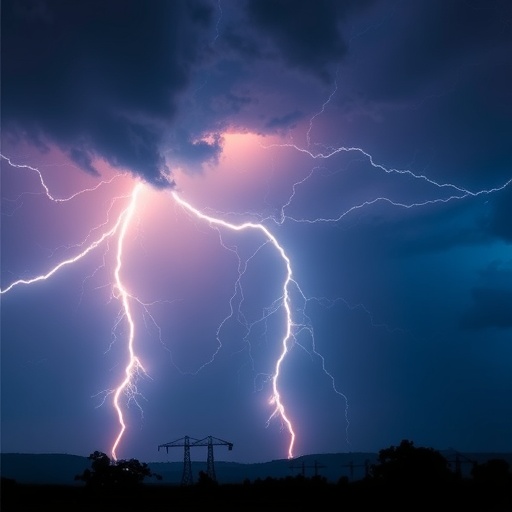A Revolutionary Leap in Lightning Forecasting: Integrating Weather Foundation Models with Neural Networks
Lightning forecasting, a notoriously complex challenge in meteorology, has recently witnessed a groundbreaking advancement through the use of hybrid artificial intelligence frameworks that leverage both long-term weather prediction models and immediate observational data. Led by a multidisciplinary team of researchers from Beijing Jiaotong University alongside specialists from the Chinese Academy of Meteorological Sciences, this latest innovation introduces a novel approach that melds the predictive strengths of Weather Foundation Models (WFMs) with real-time lightning data to generate unprecedented levels of accuracy in forecasting lightning events.
At the core of this innovation is the utilization of ERA5 atmospheric reanalysis data representing weather conditions from the past hour as initial inputs into a state-of-the-art weather foundation model, notably the Pangu-Weather framework. This system produces weather forecasts extending into the coming hours, encapsulated within a temporal forecasting window referred to as ( T_f ). To enhance geographic specificity, these broad-scale forecasts are spatially cropped to hone in on targeted local regions of interest for lightning prediction.
What truly sets this forecasting framework apart is the incorporation of recent lightning observation data spanning a shorter temporal look-back period, designated as ( T_p ). This lightning data complements WFMs by capturing the immediate dynamical and physical conditions conducive to lightning activity, which broad meteorological models may miss or underrepresent due to their coarser resolution or generalized parameterizations. The combination of these data sources introduces a sophisticated dual-stream input pipeline that feeds into a newly developed neural architecture termed the gated spatiotemporal fusion network, or gSTFNet.
The gSTFNet itself is architected around four integral modules designed to progressively encode, fuse, and decode the heterogeneous inputs. The first module—the Weather Foundation Model data encoder—transforms the numerical weather prediction outputs into a latent feature space, effectively abstracting meteorological patterns and trends. Parallel to this, the observation encoder processes the lightning observation data, extracting pertinent features that characterize recent locale-specific lightning occurrences. Bridging these disparate modalities requires the innovative third module: the gated spatiotemporal fusion module. This component attentively integrates the temporal and spatial correlations across the two input streams, overcoming challenges arising from their differing temporal scales and observational characteristics. The fusion mechanism is carefully gated to dynamically control information flow, thereby enhancing feature synergy and minimizing noise or conflicting signals. Finally, the forecasting decoder reconstructs these fused features into high-resolution spatial forecasts predicting lightning occurrence probabilities over the prescribed future horizon.
Evaluated rigorously using extensive lightning datasets from Guangdong Province spanning five years (2018–2022), this dual-source fusion framework significantly outperforms both leading traditional numerical weather prediction outputs—such as the European Centre for Medium-Range Weather Forecasts High-Resolution (ECMWF HRES) product—and state-of-the-art deep learning spatiotemporal forecasting baselines. This superiority is largely attributable to the gSTFNet’s ability to intricately capture and exploit spatiotemporal dependencies inherent in the combined datasets, outperforming approaches relying solely on either WFMs or lightning observations.
To dissect the relative contributions of each data source, the researchers implemented ablation analyses contrasting three model variants: gSTFNet-P, trained exclusively on WFM data; gSTFNet-L, trained solely on lightning observation data; and the integrated full gSTFNet which combines both streams. Interestingly, gSTFNet-P demonstrated forecast accuracy on par with, and in some cases surpassing, the HRES traditional forecast product. This result underscores the advancement and robustness inherent in modern WFMs such as Pangu-Weather for capturing underlying atmospheric trends. Conversely, gSTFNet-L excelled in short-term lightning event prediction due to lightning observations’ pronounced temporal autocorrelation, which make near-time extrapolation highly reliable. However, this variant’s performance rapidly declined at longer forecast horizons, revealing limitations absent in WFM-derived models. Ultimately, the full gSTFNet demonstrated synergistic improvements, validating the hypothesis that fusing the complementary temporal strengths of each source significantly elevates predictive skill across all forecast lead times.
From a methodological perspective, the development of a gated spatiotemporal fusion network is a technical milestone that offers a sophisticated solution to the long-standing problem of integrating multimodal time series data in meteorological contexts. The gated mechanism dynamically regulates the relative weighting of features drawn from drastically different input sources and temporal patterns, minimizing modal gap issues where heterogeneity of data conventions or scales could otherwise degrade performance. This facilitates a unified high-dimensional feature space within which meaningful spatiotemporal interactions between weather state variables and lightning incident history can be modeled effectively.
Practical implications of this work extend beyond theoretical forecasting improvements. Enhanced lightning prediction enables better early-warning systems, improved public safety, and optimized management of aviation, utilities, and outdoor event operations subject to electrical storm risks. Particularly in densely populated and industrially relevant regions like Guangdong Province, the ability to anticipate lightning with greater spatial and temporal precision can materially reduce hazards associated with lightning strikes.
Moreover, while current WFMs do not yet natively output lightning forecasts, this research demonstrates that through neural adaptation and cross-data training, their predictive outputs can be repurposed successfully for this specialized task. The approach presents a promising new paradigm for harnessing the growing power of foundational meteorological models by augmenting them with auxiliary observational streams, addressing domain-specific forecasting challenges that remain difficult for standalone NWP or deep learning systems alone.
In conclusion, this pioneering study not only advances the technical frontiers of spatiotemporal forecasting networks but also sets a new benchmark in lightning forecasting accuracy by fusing the long-term trend awareness imbued within WFMs with the immediacy and relevance of recent lightning observations. As weather prediction increasingly converges with machine learning, frameworks like the gSTFNet illustrate the immense potential for next-generation hybrid architectures poised to transform meteorology and environmental risk management.
Subject of Research:
Lightning forecasting enhancement using weather foundation models integrated with neural network architectures
Article Title:
A gated spatiotemporal fusion network for lightning forecasting based on weather foundation models
News Publication Date:
2025
Web References:
DOI: 10.1007/s11430-025-1638-8
Image Credits:
©Science China Press
Keywords:
lightning forecasting, weather foundation models, neural networks, spatiotemporal fusion, deep learning, Pangu-Weather, dual-source data integration, numerical weather prediction, gated fusion networks, short-term extrapolation, meteorological modeling, Guangdong lightning data




